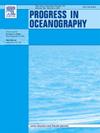Nutrient supply, prey body size and biomass determine the trophic structures in marine plankton food webs
IF 3.6
3区 地球科学
Q1 OCEANOGRAPHY
引用次数: 0
Abstract
Trophic diversity and predator–prey mass ratio (PPMR) are key indicators of trophic transfer pathways and efficiency in marine ecosystems. Horizontal trophic diversity reflects the variety of resources at the base of the planktonic food web, whereas vertical trophic diversity represents the maximum food chain length. In size-structured marine food webs, community PPMR indicates the general prey size preference of zooplankton. In this study, we used size-fractionated stable isotope analyses (δ13C and δ15N) to assess horizontal and vertical trophic diversity and community PPMR, examining how nutrient supply influences the biomass and body size distribution of prey communities, and in turn affects size-structured trophic interactions. Our long-term monitoring across a nutrient gradient revealed that higher nutrient concentrations increased horizontal trophic diversity, suggesting that zooplankton exhibit more diverse prey preferences across size classes. Conversely, an increase in large autotrophic microplankton reduced vertical trophic diversity, indicating a shift in mesozooplankton feeding from heterotrophic microplankton to autotrophs, thereby shortening the food chain. In regions with low autotrophic microplankton biomass, community PPMR decreased with increasing total prey biomass, implying that mesozooplankton preferentially fed on heterotrophic microzooplankton in picoplankton-dominated, high-productivity systems. These findings highlight how nutrient availability shapes size-structured plankton food webs by altering the biomass and size composition of prey communities.
营养供给、猎物体型和生物量决定了海洋浮游生物食物网的营养结构
营养多样性和食饵质量比(PPMR)是海洋生态系统营养转移途径和效率的关键指标。水平营养多样性反映了浮游生物食物网底部的资源多样性,而垂直营养多样性代表了食物链的最大长度。在大小结构的海洋食物网中,群落PPMR反映了浮游动物对猎物大小的偏好。本研究采用粒径分步稳定同位素分析(δ13C和δ15N)评估了水平和垂直营养多样性和群落PPMR,研究了养分供应如何影响猎物群落的生物量和体型分布,进而影响粒径结构的营养相互作用。我们在营养梯度上的长期监测显示,更高的营养浓度增加了水平营养多样性,这表明浮游动物在不同的体型类别中表现出更多样化的猎物偏好。相反,大型自养小浮游生物的增加减少了垂直营养多样性,表明中浮游动物的摄食从异养小浮游生物转向自养,从而缩短了食物链。在自养小浮游生物生物量较低的区域,群落PPMR随着猎物总生物量的增加而降低,这表明在以微浮游生物为主的高产系统中,中浮游动物优先以异养小浮游动物为食。这些发现强调了养分供应如何通过改变猎物群落的生物量和大小组成来塑造浮游生物食物网的大小结构。
本文章由计算机程序翻译,如有差异,请以英文原文为准。
求助全文
约1分钟内获得全文
求助全文
来源期刊

Progress in Oceanography
地学-海洋学
CiteScore
7.20
自引率
4.90%
发文量
138
审稿时长
3 months
期刊介绍:
Progress in Oceanography publishes the longer, more comprehensive papers that most oceanographers feel are necessary, on occasion, to do justice to their work. Contributions are generally either a review of an aspect of oceanography or a treatise on an expanding oceanographic subject. The articles cover the entire spectrum of disciplines within the science of oceanography. Occasionally volumes are devoted to collections of papers and conference proceedings of exceptional interest. Essential reading for all oceanographers.
 求助内容:
求助内容: 应助结果提醒方式:
应助结果提醒方式:


